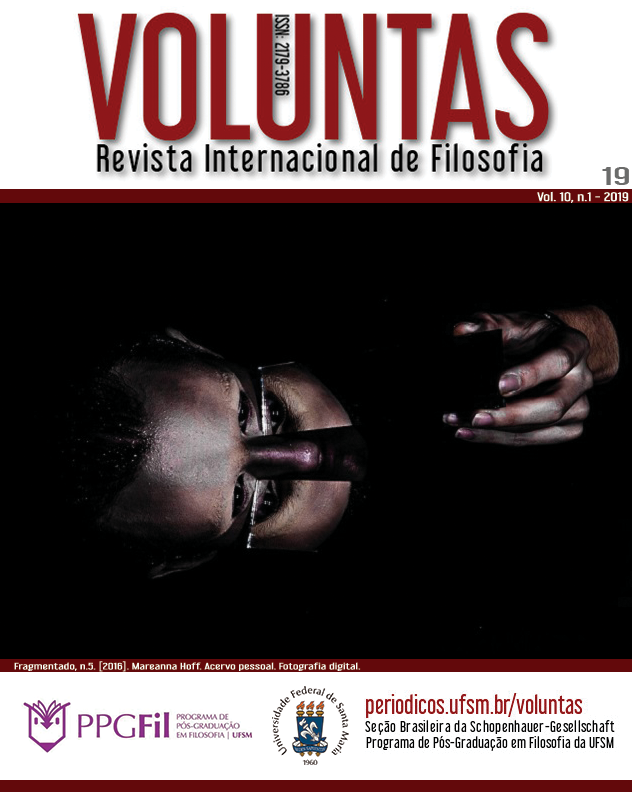Between metaphysics and physiology. Body as unitary phenomenon in Schopenhauer, Cabanis and Bichat
DOI:
https://doi.org/10.5902/2179378636648Keywords:
Leib, Unity, Physiology, Schopenhauer, Cabanis, BichatAbstract
The following essay aims to analyse one aspect of schopenhauerean interpretation of body: the idea of Leib such as unitary phenomenon, and not as term of a dualism that counterposes body to soul. According to Schopenhauer, human body, although its polysemy, is ascribable to an underlying unity, the objectivation of the will. The will is thought as passion too, interconnected with Leib, that reflects its movements. Besides, the body considered as organism and as composition of affections and thoughts is conceived as a unity of parts which relate and influence mutually. According to Schopenhauer, this interpretation is proved and shared, from a physiological point of view, by Cabanis and Bichat, in terms of belonging between physique and moral on the one hand, and in terms of interconnection between vie organique and vie animale on the other hand. The essay aims to describe this unitary interpretation and intends to illustrate to what extent the different perspectives agree.
Downloads
References
BICHAT, Xavier. Recherches physiologiques sur la vie et la mort. Paris: chez Brosson-Gabon, 1802 (deuxième edition).
BICHAT, Xavier. Ricerche fisiologiche intorno alla vita e alla morte. Prima traduzione italiana fatta sulla terza edizione francese. Pavia: nella stamperia Fusi e Comp.°, 1823.
CABANIS, Pierre. Rapporti tra il fisico e il morale dell’uomo. Prima versione italiana, eseguita sopra la terza edizione francese, preceduta per la prima volta da una tavola analitica del Conte Destutt de Tracy e seguita da una tavola alfabetica del Signor Sue, 1820; Rapporti tra il fisico e il morale dell’uomo. Traduzione parziale a cura di Sergio Moravia. Roma-Bari: Editori Laterza, 1973.
CABANIS, Pierre. Coup d’œil sur les révolutions et sur la réforme de la médecine. Paris: Crapart, Caille et Ravier, 1804.
DOBO, Nicolas, ROLE, André. Bichat. La vie fulgurante d’un génie. Paris: Perrin, 1989.
DI PALO, Lucia. Les Recherches physiologiques sur la vie et la mort di Fraçois Xavier Bichat. Un lessico fisiologico. Bari: Cacucci editore, 2005.
GRIGENTI, Fabio. Natura e rappresentazione. Genesi e struttura della natura in Arthur Schopenhauer. Istituto Italiano per gli Studi Filosofici, Napoli: La città del sole, 2000.
JANET, Paul. Schopenhauer et la physiologie française. Cabanis et Bichat. Revue des deux mondes, Paris, Mai 1880, pp. 35-59.
KLOPPE, Wolfgang. Die Bestätigung der Philosophie Arthur Schopenhauers (1788-1860) durch das Werk des Physiologen Xavier Bichat (1771-1802). Eine Begegnung von Physik und Metaphysik. Medizinische Monatsschrift, 22, 1968, pp. 306-312.
LEFRANC, Jean. Schopenhauer lecteur de Cabanis. Revue de Métaphysique et de Morale, v. 88, n. 4, 1983, pp. 549–557.
MANDELBAUM, Maurice. The Physiological Orientation of Schopenhauer's Epistemology, in FOX, Michael (ed. by). Schopenhauer. His Philosophical Achievement. Totowa (N.J.): Barnes & Noble Books, 1980, pp. 50-67.
MORAVIA, Sergio. Introduzione, in CABANIS, Pierre-Jean-Georges. Rapporti tra il fisico e il morale dell’uomo. Roma-Bari: editori Laterza, 1973, pp. VII-XXXIX.
MORAVIA, Sergio. Il pensiero degli idéologues. Scienza e filosofia in Francia (1780-1815). Firenze: La nuova Italia, 1974.
MORAVIA, Sergio. La filosofia degli idéologues. Scienza dell’uomo e riflessione epistemologica tra Sette e Ottocento, in SANTATO, Guido (a cura di). Letteratura italiana e cultura europea tra Illuminismo e Romanticismo, Atti del Convegno Internazionale di Studi, Padova-Venezia, 11-13 maggio 2000. Genève: Librairie Droz S.A., 2003, pp. 65-79.
SCHOPENHAUER, Arthur. La vista e i colori e carteggio con Goethe. A cura di Mazzino Montinari. Milano: Abscondita, 2002.
SCHOPENHAUER, Arthur. Il mondo come volontà e rappresentazione, volume I e II. Introduzione e traduzione di Sossio Giametta, bibliografia e indici di Vincenzo Cicero. Milano: Bompiani, 2010.
SCHOPENHAUER, Arthur. Sulla volontà nella natura. A cura di Sossio Giametta. Milano: BUR, 2010.
SCHOPENHAUER, Arthur. La libertà del volere umano. Introduzione di Cesare Vasoli, traduzione di Ervino Pocar. Roma-Bari: Laterza, 1970.
SCHOPENHAUER, Arthur. Parerga e Paralipomena. Scritti filosofici minori. Tomo primo a cura di Giorgio Colli, tomo secondo a cura di Mario Carpitella, tr. it. di Mazzino Montinari e Eva Kühn Amendola. Milano: Adelphi, 2007.
SCHOPENHAUER, Arthur. Scritti Postumi, volume I, I manoscritti giovanili (1804-1818). Testo stabilito da Arthur Hübscher, edizione italiana diretta da Franco Volpi, volume a cura di Sandro Barbera. Milano: Adelphi, 1996.
SCHOPENHAUER, Arthur. Scritti Postumi, volume III, I manoscritti berlinesi (1818-1830). Testo stabilito da Arthur Hübscher, edizione italiana diretta da Franco Volpi, volume a cura di Giovanni Gurisatti. Milano: Adelphi, 2004.
SCHOPENHAUER, Arthur. Lezioni filosofiche, II, Metafisica della natura. A cura di Ignazio Volpicelli. Roma-Bari: Laterza, 2007.
SCHMIDT, Alfed. Physiologie und Transzendentalphilosophie bei Schopenhauer. Schopenhauer-Jahrbuch, 1989, pp. 43-53.
SCHUBBE, Daniel, SØREN, R. Fauth. Schopenhauer und Goethe. Biographische und philosophische Perspektiven. Hamburg: Felix Meiner Verlag, 2016.
SEGALA, Marco. Fisiologia e metafisica in Schopenhauer. Rivista di filosofia, v. LXXXV, n. 1, 1994, pp. 35-66.
SEGALA, Marco. Schopenhauer, Goethe e l’ottica sperimentale. Rivista di Filosofia, v. XCVI, n. 2, 2005, pp. 217-231.
SEGALA, Marco. Schopenhauer, la filosofia, le scienze. Pisa: Edizioni della Normale, 2009.
SEGALA, Marco. The Role of Physiology in Schopenhauer’s Metaphysics of Nature. Schopenhauer-Jahrbuch, 2012, pp. 327-334.
VOLPICELLI, Ignazio. A. Schopenhauer. La natura vivente e le sue forme. Settimo milanese: Marzorati editore, 1988.
TAKAHASHI, Yoichiro. Lebensphänomenologie durch Physiologie in der mittleren und späten Periode Schopenhauers. Schopenhauer-Jahrbuch, 2012, pp. 163-174.
Downloads
Published
How to Cite
Issue
Section
License
The submission of original manuscripts to this journal implies the transference, by the authors, of the copyrights for printed and digital publication. The copyrights of a published manuscript belong ultimately to the author, and only the copyright for its first publication is reserved to the journal. Authors may only use the same results in other publications explicitly indicating this journal as the medium of the original publication.
Licence
Attribution-NonCommercial-ShareAlike 4.0 International (CC BY-NC-SA 4.0) - This license lets others remix, tweak, and build upon your work non-commercially, as long as they credit you and license their new creations under the identical terms.






